| Article ID | Journal | Published Year | Pages | File Type |
|---|---|---|---|---|
| 5043500 | Neuroscience & Biobehavioral Reviews | 2017 | 26 Pages |
â¢Macaque parieto-frontal circuits involved in visuomotor transformations for grasping are at the core of a large-scale cortical network.â¢This network -the lateral grasping network- includes parietal and frontal opercular, inferotemporal, ventrolateral prefrontal, and insular sectors.â¢The lateral grasping network is a possible substrate for interfacing perceptual, cognitive, limbic and hand-related sensorimotor processes.â¢This network could play a primary role when hand actions require management of pictorial cues, learned object knowledge and contextual information.â¢There is evidence for a possible human counterpart of the macaque lateral grasping network.
In primates, neural mechanisms for controlling skilled hand actions primarily rely on sensorimotor transformations. These transformations are mediated by circuits linking specific inferior parietal with ventral premotor areas in which sensory coding of objects' features automatically triggers appropriate hand motor programs. Recently, connectional studies in macaques showed that these parietal and premotor areas are nodes of a large-scale cortical network, designated as “lateral grasping network,” including specific temporal and prefrontal sectors involved in object recognition and executive functions, respectively. These data extend grasping models so far proposed in providing a possible substrate for interfacing perceptual, cognitive, and hand-related sensorimotor processes for controlling hand actions based on object identity, goals, and memory-based or contextual information and for the contribution of motor signals to cognitive motor functions. Human studies provided evidence for a possible counterpart of the macaque lateral grasping network, suggesting that in primate evolution the neural mechanisms for controlling hand actions described in the macaque have been retained and exploited for the emergence of human-specific motor and cognitive motor capacities.
